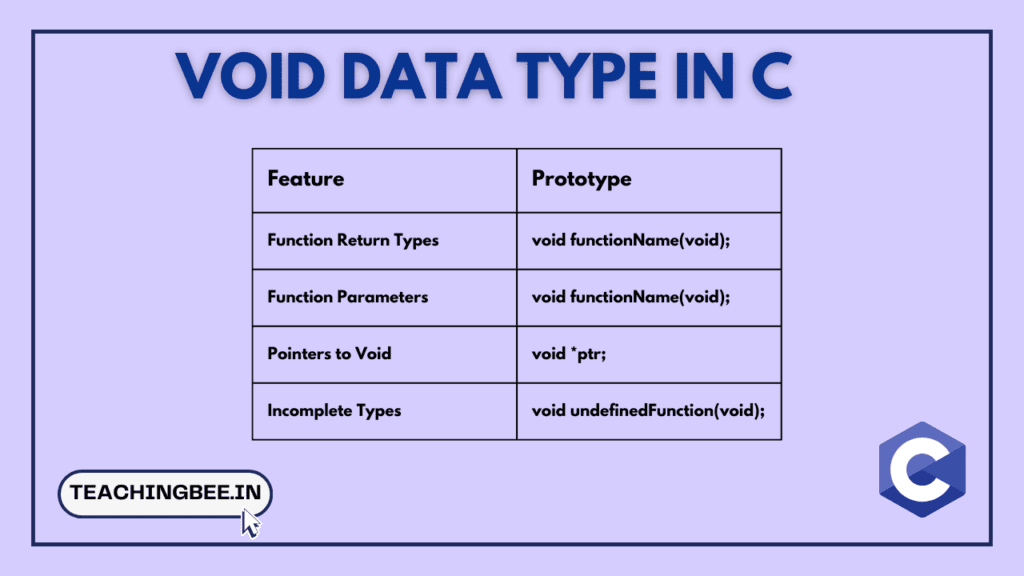Table of Contents
ToggleIn the C programming language, the void data type occupies a unique place. Unlike other data types that specify what type of data a variable can hold, the void type, paradoxically, specifies an absence of data.
In this article we will look into the void data type, exploring its semantics, uses, and implications in C programming.
What is Void Data Type In C?
A void data type in C represents the absence of type information. It indicates that no value is available. Void Data Type is a keyword in the C language that represents the idea of “nothing” or “no type“.
This might seem abstract or counterintuitive at first glance, especially when compared to more concrete types like integers, floating-point numbers, or characters. However, the void type’s utility becomes apparent in its ability to enable certain programming constructs that would otherwise be difficult or impossible.
Semantics and Syntax Of Void Data Type In C
In C, the void keyword is used in several contexts, each with its specific semantics and implications. The most common uses of the void type include:
- Function Return Types: A function declared to return void does not return a value to its caller. Such functions are called for their side effects rather than for their return values.
- Function Parameters: Functions can have parameters of type void, indicating that they do not accept any arguments.
- Pointers to Void: A pointer of type void * can point to objects of any data type. This is a powerful feature for generic programming and is extensively used in dynamic memory allocation, data structures, and function pointers.
- Incomplete Types: The void type can represent an incomplete type that cannot be completed. This is used in scenarios where the actual type is irrelevant or to be defined later.
| Feature | Prototype |
|---|---|
| Function Return Types | void functionName(void); |
| Function Parameters | void functionName(void); |
| Pointers to Void | void *ptr; |
| Incomplete Types | void undefinedFunction(void); |
Function Return Types
When a function is declared to return void, it explicitly states that its purpose is not to produce a value but to perform an action. For example, a function that prints a message on the screen might return void since its primary effect is the side effect of printing, rather than producing a value.
void printMessage() {
printf("Hello, World!\n");
}This function can be called whenever the message needs to be printed, but it cannot be used in expressions expecting a value, highlighting the role of void in specifying “no return value”.
Function Parameters
A function with void parameters signifies that it does not accept any arguments. This is less common but is useful for callbacks or function pointers that need to conform to a specific signature.
void timerCallback(void) {
// Code to execute when timer expires
}This function, intended to be called by a timer mechanism, does not need any external data to perform its task, as indicated by the void parameter list.
Pointers to Void
Perhaps the most versatile use of the void type is in the form of void pointers. A void pointer can point to any data type, making it a powerful tool for generic programming. For example, the standard library functions malloc and free use void pointers to allocate and deallocate memory without knowing the type of data stored.
void* ptr = malloc(100); // Allocates 100 bytes of memoryThis pointer can then be cast to any desired type, providing a flexible way to work with memory in a type-agnostic manner.
Incomplete Types
In some advanced programming scenarios, it may be necessary to declare a type without specifying its complete structure. The void type facilitates this by allowing the declaration of pointers to an incomplete type. This is particularly useful in hiding implementation details in modular programming.
Here is an example code snippet demonstrating the use of pointers to incomplete types using the void pointer in C:
// foo.h
typedef struct foo Foo;
// Declare pointer to incomplete type Foo
void processFoo(Foo *f);
// foo.c
#include "foo.h"
// Actual definition of Foo
struct foo {
int x;
float y;
};
// Function definition uses concrete Foo type
void processFoo(Foo *f) {
// Access members of Foo
f->x = 5;
f->y = 2.5;
printf("x: %d, y: %f", f->x, f->y);
}
int main() {
Foo f;
processFoo(&f);
return 0;
}Here, the pointer processFoo in header file foo.h declares Foo as an incomplete type using a forward declaration via typedef. The actual concrete definition of Foo is hidden and exists only in the .c file. This shows how pointers can be declared to incomplete types before their full declaration.
Practical Applications and Examples
The void type’s utility extends beyond the theoretical to practical applications in real-world programming. Here are some examples illustrating its use:
- Dynamic Memory Allocation: Functions like
mallocandfreerely on void pointers to provide memory management capabilities without being tied to a specific type. - Generic Data Structures: Linked lists, trees, and other data structures can use void pointers to store data of any type, making them more flexible.
- Callback Functions: In event-driven programming, callback functions often use void parameters and return types to fit into a generic event-handling framework.
- API Design: Libraries and APIs use void pointers to allow for generic interfaces that can work with any type of data.
Key TakeAways
- The void data type in C represents the absence of type, useful for functions that don’t return values and for pointers that can point to any data type.
- Void functions in C do not return any values, instead performing side-effects like I/O, while void parameters indicate a function accepts no arguments.
- Void pointers enable type-generic programming, used extensively in memory allocation, data structures, callbacks and APIs to operate on data of any type through a single interface.
- The void data type facilitates incomplete types via forward declarations and typedefs, crucial for information hiding and modular programming by deferring full type details.
- Practical applications of the void type include dynamic memory management, flexible data structures like linked lists, loosely coupled event-based systems using callback functions and writing generic reusable libraries.
Similar Posts
Checkout more C Tutorials here.
I hope You liked the post 👍. For more such posts, 📫 subscribe to our newsletter. Try out our free resume checker service where our Industry Experts will help you by providing resume score based on the key criteria that recruiters and hiring managers are looking for.
FAQ
What is a void data type?
A void data type in C represents the absence of type information. It indicates that no value is available.
When to use void * in C?
void * in C is used when you want to create a pointer that can point to any data type without specifying its type explicitly. It’s often used in situations where the specific type of data is unknown or can vary.
What is use of void main in C?
Void main () is the entry point for execution in C program. void main() in C is considered incorrect usage. The correct signature for the main function in C is int main(), which returns an integer status code indicating the exit status of the program. Some compilers allow void main() to maintain compatibility with older non-standard dialects of C. But it usually results in a warning, and should be avoided.
What is void pointer in C?
A void pointer in C is a pointer that has no associated data type information. It can be used to store the address of any data type, but you need to explicitly cast it to the appropriate type before dereferencing it.


